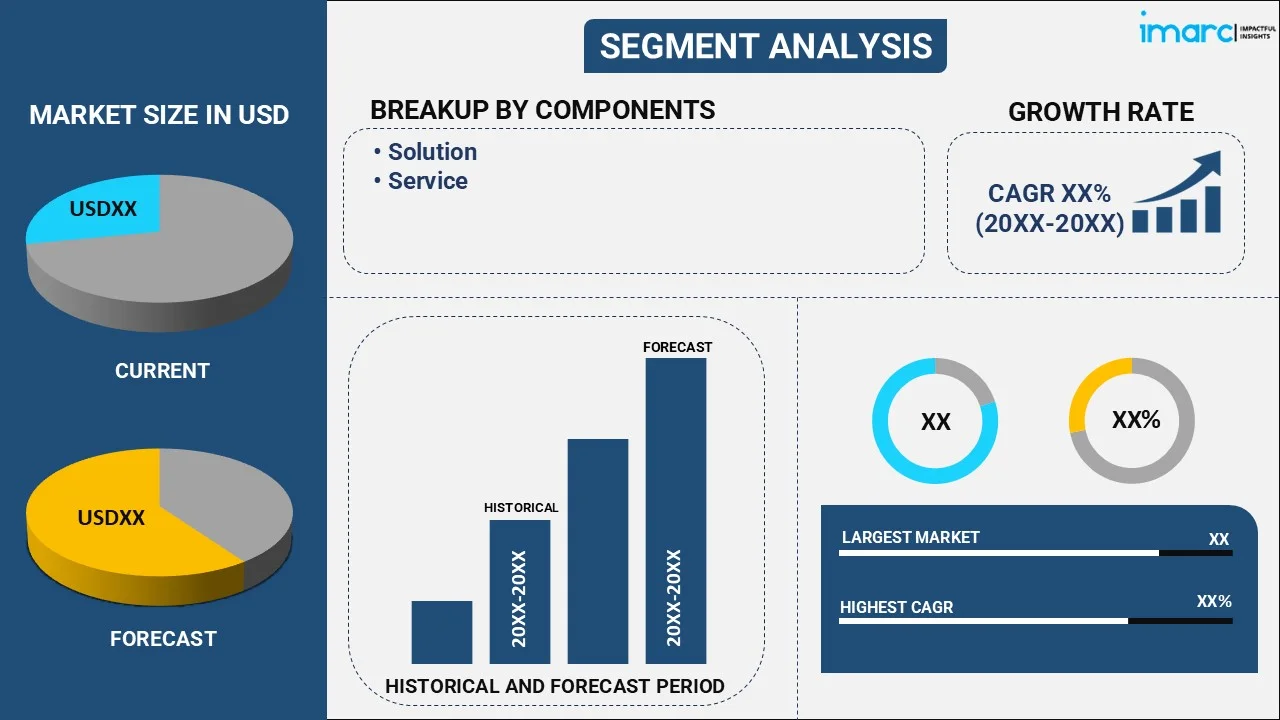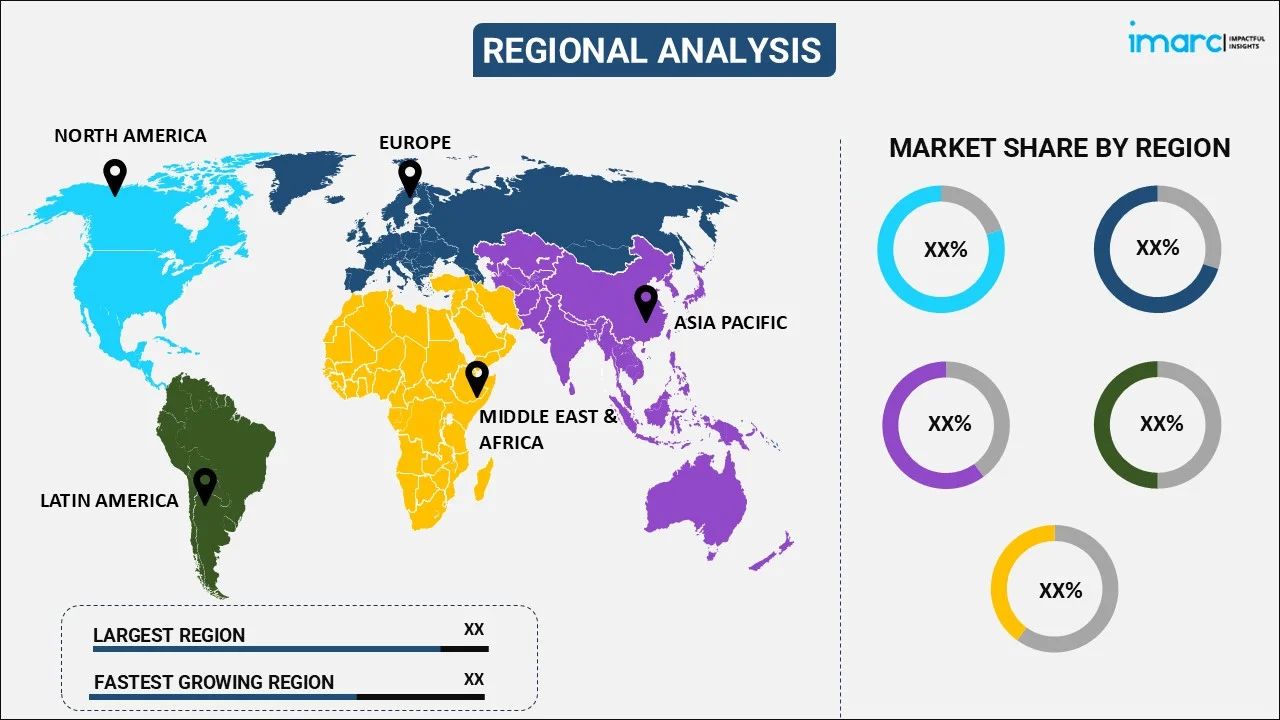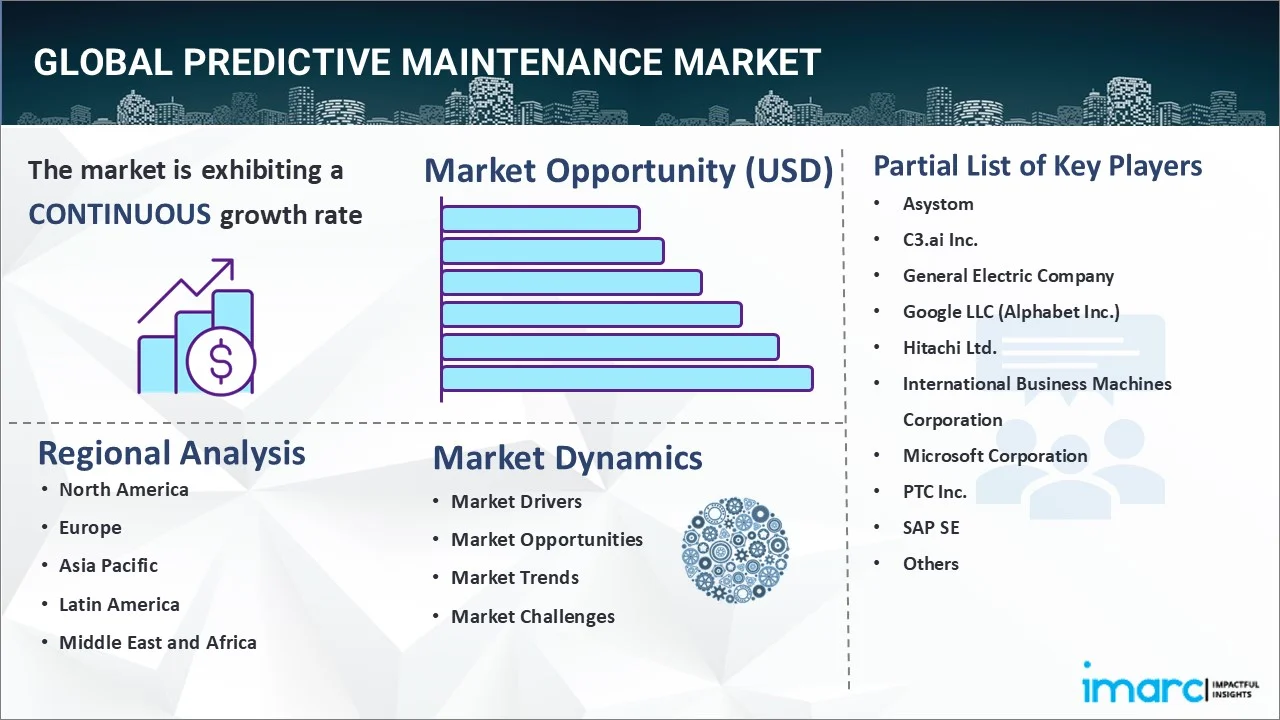
Predictive Maintenance Market Report by Component (Solution, Service), Technique (Vibration Monitoring, Electrical Testing, Oil Analysis, Ultrasonic Leak Detectors, Shock Pulse, Infrared, and Others), Deployment Type (Cloud-based, On-premises), Organization Size (Small and Medium-sized Enterprises, Large Enterprises), Industry Vertical (Manufacturing, Energy and Utilities, Aerospace and Defense, Transportation and Logistics, Government, Healthcare, and Others), and Region 2025-2033
Global Predictive Maintenance Market:
The global predictive maintenance market size reached USD 12.7 Billion in 2024. Looking forward, IMARC Group expects the market to reach USD 80.6 Billion by 2033, exhibiting a growth rate (CAGR) of 22.8% during 2025-2033. The growing use of machine-to-machine (M2M) communication, coupled with the rising integration with remote monitoring to conduct advanced inspections, is primarily propelling the market.
|
Report Attribute
|
Key Statistics
|
|---|---|
|
Base Year
|
2024
|
|
Forecast Years
|
2025-2033
|
|
Historical Years
|
2019-2024
|
| Market Size in 2024 | USD 12.7 Billion |
| Market Forecast in 2033 | USD 80.6 Billion |
| Market Growth Rate (2025-2033) | 22.8% |
Predictive Maintenance Market Analysis:
- Major Market Drivers: The growing automation of several industrial assets, along with the inflating need to prevent the disruption of production cycles, is primarily catalyzing the market.
- Key Market Trends: The rising investments in extending the lifespan of numerous aging industrial machinery are among the emerging trends fueling the market. Besides this, the elevating employment of predictive maintenance in the healthcare sector to enhance the reliability of healthcare infrastructures is also acting as another significant growth-inducing factor.
- Competitive Landscape: Some of the prominent companies in the global market include Asystom, C3.ai Inc., General Electric Company, Google LLC (Alphabet Inc.), Hitachi Ltd., International Business Machines Corporation, Microsoft Corporation, PTC Inc., SAP SE, Software AG, Tibco Software Inc., and Uptake Technologies Inc., among many others.
- Geographical Trends: North America exhibits a clear dominance in the market, owing to the escalating demand for remote monitoring facilities. Apart from this, continuous technological advancements in business automation processes are also bolstering the regional market.
- Challenges and Opportunities: One of the primary challenges hindering the market is the integration and analysis of vast amounts of data from several sources. However, the development of advanced machine learning algorithms is anticipated to fuel the market over the forecasted period.
Predictive Maintenance Market Trends:
Rising Integration of AI
The growing adoption of artificial intelligence in predictive maintenance, which can analyze vast amounts of data from various sensors in real-time to detect patterns and predict equipment failures more accurately, is bolstering the market. For example, in July 2024, Guidewheel, the leading AI-powered FactoryOps platform, introduced Scout, a new product to help manufacturers predict maintenance needs and detect early warning signals of issues before they lead to machine downtime or failure. This, in turn, is elevating the predictive maintenance market statistics.
Growing Use of IoT Sensors
The increasing usage of Internet of Things (IoT) sensors is transforming predictive maintenance. IoT sensors provide continuous data on environmental conditions, equipment performance, operational parameters, etc. Moreover, this data helps in the early detection of anomalies and potential failures. For instance, manufacturing giants like Honeywell and Siemens deploy IoT sensors across their machinery to monitor temperature, vibrations, and pressure, thereby ensuring timely maintenance interventions. The trend of IoT sensor adoption is driving more effective and data-driven maintenance strategies, which is escalating the predictive maintenance market demand.
Increasing Focus on Cybersecurity
As predictive maintenance systems extensively rely on connected devices and data exchange, cybersecurity has become an important trend. Moreover, protecting sensitive maintenance data and ensuring the integrity of predictive algorithms against cyber threats is paramount. Companies are extensively investing in robust cybersecurity measures to safeguard their predictive maintenance infrastructure. For instance, IBM and GE incorporate authentication protocols, advanced encryption, and continuous monitoring to secure their predictive maintenance systems. This focus on cybersecurity helps maintain trust and reliability in predictive maintenance solutions, which is elevating the predictive maintenance market's recent price.
Global Predictive Maintenance Industry Segmentation:
IMARC Group provides an analysis of the key trends in each segment of the market, along with the predictive maintenance market forecast at the global, regional, and country levels for 2025-2033. Our report has categorized the market based on the component, technique, deployment type, organization size, and industry vertical.
Breakup by Component:

- Solution
- Service
The solution currently exhibits a clear dominance in the market
The report has provided a detailed breakup and analysis of the market based on the component. This includes solution and service. According to the report, the solution represented the largest market segmentation.
The solution encompasses comprehensive software and hardware systems designed to monitor and analyze equipment performance continuously. For example, IBM's Maximo Asset Performance Management offers an integrated suite that uses IoT sensors and AI to predict equipment failures before they occur, thereby significantly reducing downtime and maintenance costs.
Breakup by Technique:
- Vibration Monitoring
- Electrical Testing
- Oil Analysis
- Ultrasonic Leak Detectors
- Shock Pulse
- Infrared
- Others
Currently, vibration monitoring holds the largest predictive maintenance market share
The report has provided a detailed breakup and analysis of the market based on the technique. This includes vibration monitoring, electrical testing, oil analysis, ultrasonic leak detectors, shock pulse, infrared, and others. According to the report, vibration monitoring represented the largest market segmentation.
Vibration monitoring represents the largest segmentation in the market because it is a highly effective method for the early detection of equipment anomalies and potential failures. For instance, General Electric (GE) uses advanced vibration monitoring systems in its turbines to detect imbalances, misalignments, and wear in real-time, allowing for timely maintenance interventions that prevent costly breakdowns.
Breakup by Deployment Type:
- Cloud-based
- On-premises
On-premises accounted for the largest predictive maintenance market revenue
The report has provided a detailed breakup and analysis of the market based on the deployment type. This includes cloud-based and on-premises. According to the report, on-premises represented the largest market segmentation.
On-premises solutions represent the largest segmentation in the predictive maintenance market outlook due to their ability to offer enhanced control, security, and customization tailored to specific enterprise needs. For example, the Siemens SIMATIC PCS 7 system is an on-premises solution that integrates predictive maintenance capabilities directly within a company's existing infrastructure, ensuring data remains secure and compliant with industry regulations.
Breakup by Organization Size:
- Small and Medium-sized Enterprises
- Large Enterprises
Large enterprises account for the majority of the total market share
The report has provided a detailed breakup and analysis of the market based on the organization size. This includes small and medium-sized enterprises and large enterprises. According to the report, large enterprises represented the largest market segmentation.
Large enterprises represent the largest segmentation in the predictive maintenance market overview due to their substantial operational scale, financial resources, and the critical need to minimize downtime in extensive and complex infrastructures. For example, Boeing utilizes predictive maintenance to monitor its fleet of aircraft, leveraging advanced analytics to foresee potential issues and schedule timely maintenance, thereby ensuring maximum operational efficiency and safety.
Breakup by Industry Vertical:
- Manufacturing
- Energy and Utilities
- Aerospace and Defense
- Transportation and Logistics
- Government
- Healthcare
- Others
Manufacturing accounts for the majority of the total market share
The report has provided a detailed breakup and analysis of the market based on the industry vertical. This includes manufacturing, energy and utilities, aerospace and defense, transportation and logistics, government, healthcare, and others. According to the report, manufacturing represented the largest market segmentation.
Manufacturing represents the largest segmentation in the market due to the industry's critical reliance on maintaining continuous production and preventing costly downtime. For example, companies like Siemens use predictive maintenance to monitor their assembly lines, employing sensors and analytics to predict machine failures and schedule maintenance proactively, thus avoiding unexpected production stoppages. Similarly, automotive manufacturers like Ford implement predictive maintenance to keep their production equipment running smoothly, using data analytics to identify potential issues before they escalate into major problems. This represents the predictive maintenance market's recent opportunities.
Breakup by Region:

- North America
- United States
- Canada
- Asia-Pacific
- China
- Japan
- India
- South Korea
- Australia
- Indonesia
- Others
- Europe
- Germany
- France
- United Kingdom
- Italy
- Spain
- Russia
- Others
- Latin America
- Brazil
- Mexico
- Others
- Middle East and Africa
North America currently dominates the market
The market research report has also provided a comprehensive analysis of all the major regional markets, which include North America (the United States and Canada); Asia Pacific (China, Japan, India, South Korea, Australia, Indonesia, and others); Europe (Germany, France, the United Kingdom, Italy, Spain, Russia, and others); Latin America (Brazil, Mexico, and others); and the Middle East and Africa. According to the report, North America accounted for the largest market share.
The North American predictive maintenance market is thriving, driven by the region's advanced technological infrastructure, high adoption rates of IoT and AI, and a strong focus on reducing operational costs across various industries. For instance, General Electric (GE) utilizes predictive maintenance solutions in its power plants across the United States, leveraging data analytics to foresee equipment failures and optimize maintenance schedules, thereby enhancing operational efficiency and reliability. In the automotive sector, Ford's manufacturing plants in North America employ predictive maintenance to monitor machinery health and preemptively address potential issues, minimizing downtime and maintenance expenses. Additionally, North America's robust regulatory framework and emphasis on industrial safety further propel the adoption of predictive maintenance solutions, positioning the region as a leader in this market.
Competitive Landscape:
The market research report has provided a comprehensive analysis of the competitive landscape. Detailed profiles of all major predictive maintenance market companies have also been provided. Some of the key players in the market include:
- Asystom
- C3.ai Inc.
- General Electric Company
- Google LLC (Alphabet Inc.)
- Hitachi Ltd.
- International Business Machines Corporation
- Microsoft Corporation
- PTC Inc.
- SAP SE
- Software AG
- Tibco Software Inc.
- Uptake Technologies Inc.
(Please note that this is only a partial list of the key players, and the complete list is provided in the report.)
Predictive Maintenance Market Recent Developments:
- July 2024: Senzit, a leading predictive maintenance technologies company for heavy-duty industries, announced the launch of its latest product, Senzit Pro, which is designed to provide a streamlined diagnostics solution for fleet managers.
- July 2024: I-care Group agreed with Sensirion Connected Solutions GmbH to acquire assets and licenses of its predictive maintenance product line.
- July 2024: ManWinWin Software introduced its predictive maintenance offerings to address equipment failures before they occur proactively.
Predictive Maintenance Market Report Scope:
| Report Features | Details |
|---|---|
| Base Year of the Analysis | 2024 |
| Historical Period | 2019-2024 |
| Forecast Period | 2025-2033 |
| Units | Billion USD |
| Scope of the Report | Exploration of Historical Trends and Market Outlook, Industry Catalysts and Challenges, Segment-Wise Historical and Predictive Market Assessment:
|
| Components Covered | Solution, Service |
| Techniques Covered | Vibration Monitoring, Electrical Testing, Oil Analysis, Ultrasonic Leak Detectors, Shock Pulse, Infrared, Others |
| Deployment Types Covered | Cloud-based, On-premises |
| Organization Sizes Covered | Small and Medium-sized Enterprises, Large Enterprises |
| Industry Verticals Covered | Manufacturing, Energy and Utilities, Aerospace and Defense, Transportation and Logistics, Government, Healthcare, Others |
| Regions Covered | Asia Pacific, Europe, North America, Latin America, Middle East and Africa |
| Countries Covered | United States, Canada, Germany, France, United Kingdom, Italy, Spain, Russia, China, Japan, India, South Korea, Australia, Indonesia, Brazil, Mexico |
| Companies Covered | Asystom, C3.ai Inc., General Electric Company, Google LLC (Alphabet Inc.), Hitachi Ltd., International Business Machines Corporation, Microsoft Corporation, PTC Inc., SAP SE, Software AG, Tibco Software Inc., Uptake Technologies Inc., etc. |
| Customization Scope | 10% Free Customization |
| Post-Sale Analyst Support | 10-12 Weeks |
| Delivery Format | PDF and Excel through Email (We can also provide the editable version of the report in PPT/Word format on special request) |
Key Benefits for Stakeholders:
- IMARC's industry report offers a comprehensive quantitative analysis of various market segments, historical and current market trends, market forecasts, and dynamics of the predictive maintenance market from 2019-2033.
- The research report provides the latest information on the market drivers, challenges, and opportunities in the global predictive maintenance market.
- The study maps the leading, as well as the fastest-growing, regional markets. It further enables stakeholders to identify the key country-level markets within each region.
- Porter's five forces analysis assists stakeholders in assessing the impact of new entrants, competitive rivalry, supplier power, buyer power, and the threat of substitution. It helps stakeholders to analyze the level of competition within the predictive maintenance industry and its attractiveness.
- The competitive landscape allows stakeholders to understand their competitive environment and provides insight into the current positions of key players in the market.
Key Questions Answered in This Report
The global predictive maintenance market was valued at USD 12.7 Billion in 2024.
We expect the global predictive maintenance market to exhibit a CAGR of 22.8% during 2025-2033.
The rising adoption of real-time streaming analytics technologies, such as predictive maintenance, across various organizations to constantly process and analyze data records is primarily driving the global predictive maintenance market growth.
The sudden outbreak of the COVID-19 pandemic has led to the rising adoption of predictive maintenance technology to track remote working and asset management during the implementation of stringent lockdown regulations across several nations.
Based on the component, the global predictive maintenance market can be segmented into solution and service. Currently, the solution holds the majority of the total market share.
Based on the technique, the global predictive maintenance market has been divided into vibration monitoring, electrical testing, oil analysis, ultrasonic leak detectors, shock pulse, infrared, and others. Among these, vibration monitoring currently exhibits a clear dominance in the market.
Based on the deployment type, the global predictive maintenance market can be categorized into cloud- based and on-premises. Currently, on-premises deployment accounts for the majority of the global market share.
Based on the organization size, the global predictive maintenance market has been segregated into small and medium-sized enterprises and large enterprises, where large enterprises currently hold the largest market share.
Based on the industry vertical, the global predictive maintenance market can be bifurcated into manufacturing, energy and utilities, aerospace and defense, transportation and logistics, government, healthcare, and others. Among these, the manufacturing industry exhibits a clear dominance in the market.
On a regional level, the market has been classified into North America, Asia-Pacific, Europe, Latin America, and Middle East and Africa, where North America currently dominates the global market.
Some of the major players in the global predictive maintenance market include Asystom, C3.ai Inc., General Electric Company, Google LLC (Alphabet Inc.), Hitachi Ltd., International Business Machines Corporation, Microsoft Corporation, PTC Inc., SAP SE, Software AG, Tibco Software Inc., and Uptake Technologies Inc.
Need more help?
- Speak to our experienced analysts for insights on the current market scenarios.
- Include additional segments and countries to customize the report as per your requirement.
- Gain an unparalleled competitive advantage in your domain by understanding how to utilize the report and positively impacting your operations and revenue.
- For further assistance, please connect with our analysts.

 Inquire Before Buying
Inquire Before Buying
 Speak to an Analyst
Speak to an Analyst
 Request Brochure
Request Brochure
 Request Customization
Request Customization




.webp)




.webp)












